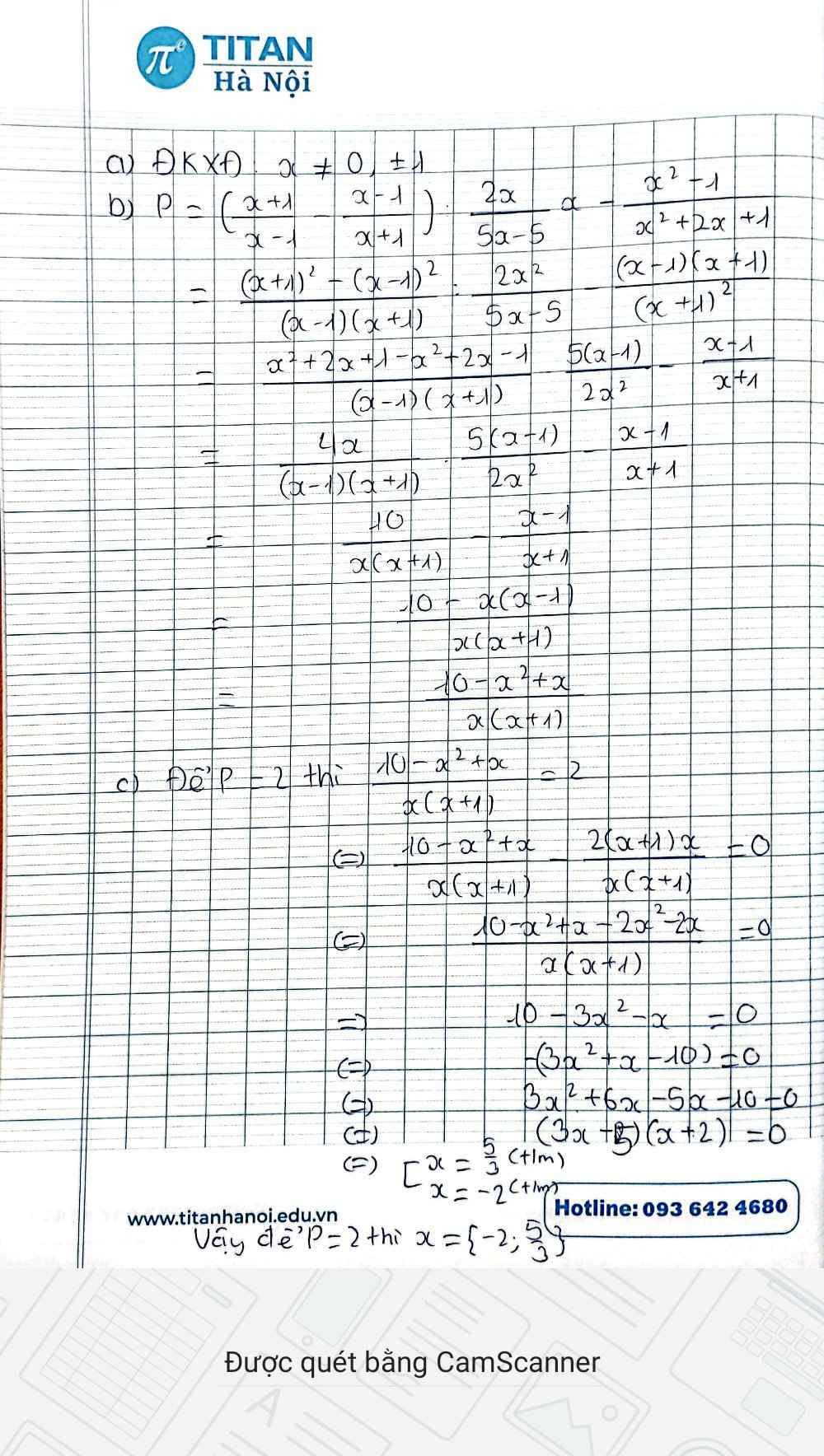A=\(\dfrac{x^2+2x}{2x+10}+\dfrac{x-5}{x}+\dfrac{50-5x}{2x\left(x+5\right)}\)
a) Tìm x để A xác định
b) Rút gọn A
c) Tìm x để A=1
Mấy pro toán chỉ mình nha
C = \(\dfrac{x^2+2x}{2x+10^{ }}+\dfrac{x-5}{x}+\dfrac{50-5x}{2x\left(x+5\right)}\)
a, Tìm ĐKXĐ và rút gọn C
b, Tìm x để P được \(\dfrac{1}{4}\)
a: ĐKXĐ: \(x\notin\left\{0;-5\right\}\)
\(C=\dfrac{x^3+2x^2+2x^2-50+50-5x}{2x\left(x+5\right)}=\dfrac{x\left(x^2+4x-5\right)}{2x\left(x+5\right)}=\dfrac{x-1}{2}\)
Cho B=\(\dfrac{x^2+2x}{2x+10}+\dfrac{x-5}{x}-\dfrac{5x-50}{2x^2+10x}\)
a) Tìm điều kiện xác định và rút gọn B
b) Tìm x để B=0; B=\(\dfrac{1}{4}\)
c) Tính giá trị của B khi x=3
d) Tìm x để B<0; B>0
a) ĐKXĐ: \(x\notin\left\{0;-5\right\}\)
Ta có: \(B=\dfrac{x^2+2x}{2x+10}+\dfrac{x-5}{x}-\dfrac{5x-50}{2x^2+10x}\)
\(=\dfrac{x^2+2x}{2\left(x+5\right)}+\dfrac{x-5}{x}-\dfrac{5x-50}{2x\left(x+5\right)}\)
\(=\dfrac{x^3+2x^2}{2x\left(x+5\right)}+\dfrac{2\left(x+5\right)\left(x-5\right)}{2x\left(x+5\right)}-\dfrac{5x-50}{2x\left(x+5\right)}\)
\(=\dfrac{x^3+2x^2+2x^2-50-5x+50}{2x\left(x+5\right)}\)
\(=\dfrac{x^3+4x^2-5x}{2x\left(x+5\right)}\)
\(=\dfrac{x\left(x^2+4x-5\right)}{2x\left(x+5\right)}\)
\(=\dfrac{x^2+5x-x-5}{2\left(x+5\right)}\)
\(=\dfrac{x\left(x+5\right)-\left(x+5\right)}{2\left(x+5\right)}\)
\(=\dfrac{\left(x+5\right)\left(x-1\right)}{2\left(x+5\right)}\)
\(=\dfrac{x-1}{2}\)
b) Để B=0 thì \(\dfrac{x-1}{2}=0\)
\(\Leftrightarrow x-1=0\)
hay x=1(nhận)
Vậy: Để B=0 thì x=1
Để \(B=\dfrac{1}{4}\) thì \(\dfrac{x-1}{2}=\dfrac{1}{4}\)
\(\Leftrightarrow4\left(x-1\right)=2\)
\(\Leftrightarrow4x-4=2\)
\(\Leftrightarrow4x=6\)
hay \(x=\dfrac{3}{2}\)(nhận)
Vậy: Để \(B=\dfrac{1}{4}\) thì \(x=\dfrac{3}{2}\)
c) Thay x=3 vào biểu thức \(B=\dfrac{x-1}{2}\), ta được:
\(B=\dfrac{3-1}{2}=\dfrac{2}{2}=1\)
Vậy: Khi x=3 thì B=1
d) Để B<0 thì \(\dfrac{x-1}{2}< 0\)
\(\Leftrightarrow x-1< 0\)
\(\Leftrightarrow x< 1\)
Kết hợp ĐKXĐ, ta được:
\(\left\{{}\begin{matrix}x< 1\\x\notin\left\{0;-5\right\}\end{matrix}\right.\)
Vậy: Để B<0 thì \(\left\{{}\begin{matrix}x< 1\\x\notin\left\{0;-5\right\}\end{matrix}\right.\)
Để B>0 thì \(\dfrac{x-1}{2}>0\)
\(\Leftrightarrow x-1>0\)
hay x>1
Kết hợp ĐKXĐ, ta được: x>1
Vậy: Để B>0 thì x>1
Bài 3. Cho biểu thức: \(P=\dfrac{x^2+2x}{2x+20}+\dfrac{x-5}{x}+\dfrac{50-5x}{2x\left(x+5\right)}\)
a) Tìm điều kiện xác định của P
b) Rút gọn biểu thức P
c) Tìm giá trị của x để P = 0; P = \(\dfrac{1}{4}\)
d) Tìm giá trị của x để P > 0; P < 0
a) ĐKXĐ: \(x\ne-10;x\ne0;x\ne-5\)
b) \(P=\dfrac{x^2+2x}{2x+20}+\dfrac{x-5}{x}+\dfrac{50-5x}{2x\left(x+5\right)}\)
\(=\dfrac{x^2+2x}{2\left(x+10\right)}+\dfrac{x-5}{x}+\dfrac{50-5x}{2x\left(x+5\right)}\)
\(=\dfrac{x\left(x^2+2x\right)\left(x+5\right)}{2x\left(x+10\right)\left(x+5\right)}+\dfrac{2\left(x-5\right)\left(x+10\right)}{2x\left(x+10\right)\left(x+5\right)}+\dfrac{\left(50-5x\right)\left(x+10\right)}{2x\left(x+5\right)\left(x+10\right)}\)
\(=\dfrac{x^4+7x^3+10x^2+2x^2+10x-100+500-5x^2}{2x\left(x+10\right)\left(x+5\right)}\)
\(=\dfrac{x^4+7x^3+7x^2+10x+400}{2x\left(x+10\right)\left(x+5\right)}\)
c) \(P=0\Rightarrow x^4+7x^3+7x^2+10x+400=0\Leftrightarrow...\)
Số xấu thì câu c, d làm cũng như không. Bạn xem lại đề.
Cho biểu thức: B=\(\dfrac{x^2+2x}{2x+10}+\dfrac{x-5}{x}+\dfrac{50-5x}{2x\left(x+5\right)}\dfrac{ }{ }\)
a) Tìm điều kiện xác định của B ?
b) Tìm x để B = 0; B = \(\dfrac{1}{4}\)
Giải giúp với ạ!! Cảm ơn trước.
a) ĐKXĐ: \(x\notin\left\{0;-5\right\}\)
b) Ta có: \(B=\dfrac{x^2+2x}{2x+10}+\dfrac{x-5}{x}+\dfrac{50-5x}{2x\left(x+5\right)}\)
\(=\dfrac{x\left(x^2+2x\right)}{2x\left(x+5\right)}+\dfrac{2\left(x+5\right)\left(x-5\right)}{2x\left(x+5\right)}+\dfrac{50-5x}{2x\left(x+5\right)}\)
\(=\dfrac{x^3+2x^2+2\left(x^2-25\right)+50-5x}{2x\left(x+5\right)}\)
\(=\dfrac{x^3+2x^2+2x^2-50+50-5x}{2x\left(x+5\right)}\)
\(=\dfrac{x^3+4x^2-5x}{2x\left(x+5\right)}\)
\(=\dfrac{x\left(x^2+4x-5\right)}{2x\left(x+5\right)}\)
\(=\dfrac{x^2+4x-5}{2\left(x+5\right)}\)
\(=\dfrac{x^2+5x-x-5}{2\left(x+5\right)}\)
\(=\dfrac{x\left(x+5\right)-\left(x+5\right)}{2\left(x+5\right)}\)
\(=\dfrac{\left(x+5\right)\left(x-1\right)}{2\left(x+5\right)}\)
\(=\dfrac{x-1}{2}\)
Để B=0 thì \(\dfrac{x-1}{2}=0\)
\(\Leftrightarrow x-1=0\)
hay x=1(nhận)
Để \(B=\dfrac{1}{4}\) thì \(\dfrac{x-1}{2}=\dfrac{1}{4}\)
\(\Leftrightarrow x-1=\dfrac{1}{2}\)
hay \(x=\dfrac{3}{2}\)(nhận)
Vậy: Để B=0 thì x=1 và Để \(B=\dfrac{1}{4}\) thì \(x=\dfrac{3}{2}\)
Cho biểu thức : P = \(\dfrac{\text{x}^{\text{2}}+2x}{2x+10}+\dfrac{x-5}{x}+\dfrac{50-5x}{2x\left(x+5\right)}\)
a) Rút gọn biểu thức P
b) Tìm giá trị của x để P = 0
c) Tìm giá trị của x để P > 0, P < 0
a: \(P=\dfrac{x\left(x+2\right)}{2\left(x+5\right)}+\dfrac{x-5}{x}-\dfrac{5x-50}{2x\left(x+5\right)}\)
\(=\dfrac{x^3+2x^2+2x^2-50-5x+50}{2x\left(x+5\right)}\)
\(=\dfrac{x^3+4x^2-5x}{2x\left(x+5\right)}\)
\(=\dfrac{x\left(x+5\right)\left(x-1\right)}{2x\left(x+5\right)}=\dfrac{x-1}{2}\)
Bài 1: Cho P=\(\dfrac{1}{x+5}\)+\(\dfrac{2}{x-5}-\dfrac{2x+10}{\left(x+5\right)\left(x-5\right)}\)
a) Tìm điều kiện xác định của P
b) Rút gọn P
c) Tìm x để P=-3
d) Tìm các giá trị nguyên của x để P nhận giá trị nguyên
Bài 2: Tìm x để các phân thức sau có giá trị bằng 0
a)\(\dfrac{3x^2+6x+12}{x^3-8}\) b)\(\dfrac{2x-x^2}{x^2-4}\)
Bài 1:
\(a,ĐK:x\ne\pm5\\ b,P=\dfrac{x-5+2x+10-2x-10}{\left(x-5\right)\left(x+5\right)}=\dfrac{x-5}{\left(x-5\right)\left(x+5\right)}=\dfrac{1}{x+5}\\ c,P=-3\Leftrightarrow x+5=-\dfrac{1}{3}\Leftrightarrow x=-\dfrac{16}{3}\\ d,P\in Z\Leftrightarrow x+5\inƯ\left(1\right)=\left\{-1;1\right\}\\ \Leftrightarrow x\in\left\{-6;-4\right\}\)
Bài 2:
\(a,\Leftrightarrow\dfrac{3\left(x^2+2x+4\right)}{\left(x-2\right)\left(x^2+2x+4\right)}=\dfrac{3}{x-2}=0\Leftrightarrow x\in\varnothing\\ b,\Leftrightarrow\dfrac{x\left(2-x\right)}{\left(x-2\right)\left(x+2\right)}=0\Leftrightarrow\dfrac{-x}{x+2}=0\Leftrightarrow x=0\)
Cho biểu thức : \(P=\dfrac{x^2+2x}{2x+10}+\dfrac{x-5}{x}+\dfrac{50-5x}{2x\left(x+5\right)}\)
a, Tìm điều kiện xác định của P.
b, Rút gọn biểu thức P
c, Tìm giá trị của x để P = 0, \(P=\dfrac{1}{4}\)
d, Tìm giá trị của x để P > 0 , P < 0
a) P xác định \(\Leftrightarrow\hept{\begin{cases}2x+10\ne0\\x\ne0\\2x\left(x+5\right)\ne0\end{cases}\Leftrightarrow x\ne\left\{-5;0\right\}}\)
b) \(P=\frac{x^2+2x}{2x+10}+\frac{x-5}{x}+\frac{50-5x}{2x\left(x+5\right)}\)
\(P=\frac{x^2\left(x+2\right)}{2x\left(x+5\right)}+\frac{2\left(x-5\right)\left(x+5\right)}{2x\left(x+5\right)}+\frac{5\left(10-x\right)}{2x\left(x+5\right)}\)
\(P=\frac{x^3+2x^2+2x^2-50+50-5x}{2x\left(x+5\right)}\)
\(P=\frac{x^3+4x^2-5x}{2x\left(x+5\right)}\)
\(P=\frac{x^3+5x^2-x^2-5x}{2x\left(x+5\right)}\)
\(P=\frac{x^2\left(x+5\right)-x\left(x+5\right)}{2x\left(x+5\right)}\)
\(P=\frac{\left(x+5\right)\left(x^2-x\right)}{2x\left(x+5\right)}\)
\(P=\frac{x\left(x-1\right)}{2x}\)
\(P=\frac{x-1}{2}\)
c) Để P = 0 thì \(x-1=0\Leftrightarrow x=1\)( thỏa mãn ĐKXĐ )
Để P = 1/4 thì \(\frac{x-1}{2}=\frac{1}{4}\)
\(\Leftrightarrow4\left(x-1\right)=2\)
\(\Leftrightarrow4x-4=2\)
\(\Leftrightarrow4x=6\)
\(\Leftrightarrow x=\frac{3}{2}\)( thỏa mãn ĐKXĐ )
d) Để P > 0 thì \(\frac{x-1}{2}>0\)
Mà 2 > 0, do đó để P > 0 thì \(x-1>0\Leftrightarrow x>1\)
Để P < 0 thì \(\frac{x-1}{2}< 0\)
Mà 2 > 0, do đó để P < 0 thì \(x-1< 0\Leftrightarrow x< 1\)
\(\left(\dfrac{x+1}{x-1}-\dfrac{x-1}{x+1}\right):\dfrac{2x}{5x-5}-\dfrac{x^2-1}{x^2+2x+1}\left(x\ne\pm1;x\ne0\right)\)
a) Rút gọn A
b)Tìm x để A=2
c)Tìm giá trị nguyên của x để A nguyên
ĐKXĐ: \(x\ne\pm1;x\ne0\)
a)\(\left(\dfrac{x+1}{x-1}-\dfrac{x-1}{x+1}\right):\dfrac{2x}{5x-5}-\dfrac{x^2-1}{x^2+2x+1}\)
\(=\left(\dfrac{\left(x+1\right)^2}{\left(x-1\right)\left(x+1\right)}-\dfrac{\left(x-1\right)^2}{\left(x-1\right)\left(x+1\right)}\right):\dfrac{2x}{5x-5}-\dfrac{x^2-1}{x^2+2x+1}\)
\(=\dfrac{x^2+2x+1-\left(x^2-2x+1\right)}{\left(x-1\right)\left(x+1\right)}:\dfrac{2x}{5x-5}-\dfrac{x^2-1}{x^2+2x+1}\)
\(=\dfrac{4x}{\left(x-1\right)\left(x+1\right)}:\dfrac{2x}{5x-5}-\dfrac{x^2-1}{x^2+2x+1}\)
\(=\dfrac{4x}{\left(x-1\right)\left(x+1\right)}.\dfrac{5\left(x-1\right)}{2x}-\dfrac{x^2-1}{x^2+2x+1}\)
\(=\dfrac{10}{x+1}-\dfrac{\left(x+1\right)\left(x-1\right)}{\left(x+1\right)^2}\)
\(=\dfrac{10}{x+1}-\dfrac{x-1}{x+1}\)
\(=\dfrac{11-x}{x+1}\)
b) \(A=\dfrac{11-x}{x+1}=2\)
\(\Leftrightarrow11-x=2\left(x+1\right)\)
\(\Leftrightarrow11-x=2x+2\)
\(\Leftrightarrow-x-2x=2-11\)
\(\Leftrightarrow-3x=-9\)
\(\Leftrightarrow x=3\left(nhận\right)\)
c) -Để \(A=\dfrac{11-x}{x+1}\in Z\) thì:
\(\left(11-x\right)⋮\left(x+1\right)\)
\(\Rightarrow\left(12-x-1\right)⋮\left(x+1\right)\)
\(\Rightarrow12⋮\left(x+1\right)\)
\(\Rightarrow\left(x+1\right)\inƯ\left(12\right)\)
\(\Rightarrow\left(x+1\right)\in\left\{1;2;3;4;6;12;-1;-2;-3;-4;-6;-12\right\}\)
\(\Rightarrow x\in\left\{2;3;5;11;-2;-3;-4;-5;-7;-13\right\}\)
Bài 1: Cho biểu thức: P =\(\left(\dfrac{x+1}{x-1}-\dfrac{x-1}{x+1}\right):\dfrac{2x}{5x-5}-\dfrac{x^2-1}{x^2+2x+1}\)
a) Tìm điều kiện của x để biểu thức P xác định.
b) Rút gọn biểu thức P.
c) Với giá trị nào của x thì P = 2.
d) Tìm các giá trị nguyên của x để P nhận giá trị nguyên.

Mình phải đi ăn nên chiều mình làm nốt câu d nhé
a) Điều kiện để P được xác định là: \(x\ne1;x\ne-1\)
b) \(P=\left(\dfrac{x+1}{x-1}-\dfrac{x-1}{x+1}\right):\dfrac{2x}{5x-5}x-\dfrac{x^2-1}{x^2+2x+1}\)
\(P=\left(\dfrac{\left(x+1\right)\left(x-1\right)-\left(x+1\right)\left(x-1\right)}{\left(x+1\right)\left(x-1\right)}\right):\dfrac{2x}{5x-5}x-\dfrac{\left(x+1\right)\left(x-1\right)}{\left(x+1\right)^2}\)
\(P=0:\dfrac{2x}{5x-5}x-\dfrac{x-1}{x+1}\)
\(P=-\dfrac{x-1}{x+1}\)
c) Theo đề ta có:
\(P=2\)
\(\Leftrightarrow-\dfrac{x-1}{x+1}=2\)
\(\Leftrightarrow-\left(x-1\right)=2x+2\)
\(\Leftrightarrow-x-2x=2-1\)
\(\Leftrightarrow-3x=1\)
\(\Leftrightarrow x=-\dfrac{1}{3}\)
d) \(P=-\dfrac{x-1}{x+1}\) nguyên khi:
\(\Leftrightarrow x-1⋮-\left(x+1\right)\)
\(\Leftrightarrow\left(x+1\right)-2⋮-\left(x+1\right)\)
\(\Leftrightarrow-2⋮-\left(x+1\right)\)
\(\Leftrightarrow2⋮x+1\)
\(\Rightarrow x+1\inƯ\left(2\right)\)
Vậy \(P\) nguyên khi \(x\in\left\{-2;0;-3;1\right\}\)